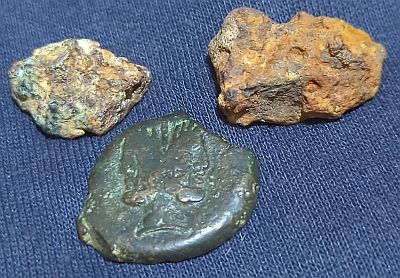The first Roman proto-coins

AES Rude translates from Latin as Rough Bronze. These were nuggets or rough irregular ingots of bronze used as a proto-currency in ancient Italy early in the gradual transition from bartering to the use of round coinage made from precious metals.
Proto-currency was an intermediate step between pure bartering (I’ll give you my potatoes for your animal fur), and money as we know it today. Proto-currency took many forms, with Cowrie shells and arrow heads being two well known examples. Some cultures started shaping metal and other things into consistent designs which were used as an early form of currency. Celtic ring money (12th – 1st Century BC), Egyptian Deban (also rings, 20th – 17th Century BC), and Wampum.
Aside from shells, most of those examples use metal. Metal is useful for making things itself, but also compact and portable, doesn’t spoil and stays the same in different regions. The Celts and Egyptians made crude shapes with their metal for trade. Chinese knife, spade and bridge money (5th – 1st century BC), and Greek dolphin money (5th – 3rd century BC) took the idea further by refining it into a particular shape, arguably making it art as well as currency.
But taking a step back to Italy, a little earlier than most shaped proto-coinage, and back to the Aes Rude. Used from the 8th – 4th century BC, it still has the core “metal is good to trade with” idea, but hasn’t yet got to any kind of refinement.
Aes Rude are basically crude lumps of metal. Pieces of no precise weight and a variety of sizes. Axe heads, rings, cast bronze shells, rods, bars, and ingots traded alongside aes rude. All bronze objects were suitable for trade by their weight and were frequently broken to adjust their weight and to make change.

I have two pieces here. One (left), which is 17-25mm diameter and weighs 12.08g. The other, larger piece (right, and also top image on page) is 20-30mm diameter and weighs 14.14 grams. These are both thicker and heavier than my later (~91 BC) Aes Grave featuring Janus. Though I think I’d rather carry around a pocket full of the later coins.
There are still several intermediate steps between these Aes rude and the Aes Grave:
- Aes Formatum – (~4th century BC) these are slightly more formed and shaped, sometimes round, dome shaped “cakes” of a set weight.
- Aes Signatum – (5th – 3rd century BC, sources vary), these were flat cast tablets or ingots decorated with emblems, often animals (Before proto-money, cattle was the de-facto monetary unit in Rome).
Attesting to the universal tradability of metal, all of these have been found widely spread around the ancient world. Italian aes rude has been found in hoards alongside aes formatum, aes signatum, Celtic ring money, all sorts of bronze objects, and coins as well, as far from Italy as Spain and Croatia.


Leave a Reply